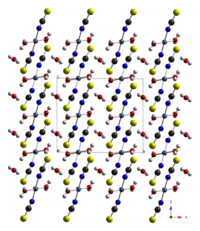- Cobalt(II) thiocyanate
-
Cobalt(II) thiocyanate 
Identifiers CAS number 3017-60-5 EC number 221-156-8 Properties Molecular formula C2CoN2S2 Molar mass 175.1 g mol−1 Hazards MSDS External MSDS EU classification  Xn
Xn  N
NR-phrases R20 R21 R22 R32 R50 R53 S-phrases S13 S60 S61  (verify) (what is:
(verify) (what is:  /
/ ?)
?)
Except where noted otherwise, data are given for materials in their standard state (at 25 °C, 100 kPa)Infobox references Cobalt(II) thiocyanate is an inorganic compound of cobalt. It is best known for the cobalt thiocyanate test (or Scott test), which is a proven screening test for the presence of cocaine.
Preparation
This compound may be prepared by the salt metathesis reaction of aqueous cobalt(II) sulfate and barium thiocyanate; barium sulfate precipitates, leaving the desired compound in solution:[1]
- CoSO4 (aq) + Ba(SCN)2 (aq) → BaSO4 (s) + Co(SCN)2 (aq)
Cobalt thiocyanate test
The cobalt thiocyanate reagent can be prepared by dissolving ten grams of cobalt (II) thiocyanate in a mixture of 490 milliliters of distilled water and 500 milliliters of glycerin.[citation needed]
The cobalt thiocyanate test is performed by placing approximately 2 to 4 milligrams of a target substance in a glass test tube, then 5 drops of cobalt thiocyanate reagent. After shaking, 1 or 2 drops of concentrated hydrochloric acid (other acids can be used[2] are added, and the tube is again shaken. Ten drops of chloroform (or similar solvent)) are then added, and the tube is vortexed, then allowed to settle and separate into two layers. The final color of the chloroform (organic) layer is recorded.
Addition of the cobalt thiocyanate reagent to cocaine hydrochloride results in the surface of the particles turning a bright blue (faint blue for cocaine base). The solution changes back to pink upon adding one or two drops of hydrochloric acid and mixing. Addition of 10 drops of chloroform, vortexing, and allowing the solution to settle results in a blue organic layer for both cocaine hydrochloride and cocaine base.
Diphenhydramine and lidocaine also give blue organic layers. These compounds are known false positives for cocaine.
References
- ^ Cano, F. H.; García-Blanco, S.; Laverat, A. G. (1976). "The crystal structure of cobalt(II) thiocyanate trihydrate". Acta Crystallographica Section B Structural Crystallography and Crystal Chemistry 32 (5): 1526. doi:10.1107/S0567740876005694.
- ^ Anna L. Deakin (2003). "A Study of Acids Used for the Acidified Cobalt Thiocyanate Test for Cocaine Base". Microgram Journal 1: 40–43. http://www.justice.gov/dea/programs/forensicsci/microgram/journal_v1/mjournal_v1_pg6a.html.
Categories:- Thiocyanates
- Cobalt compounds
- Chemical tests
Wikimedia Foundation. 2010.
